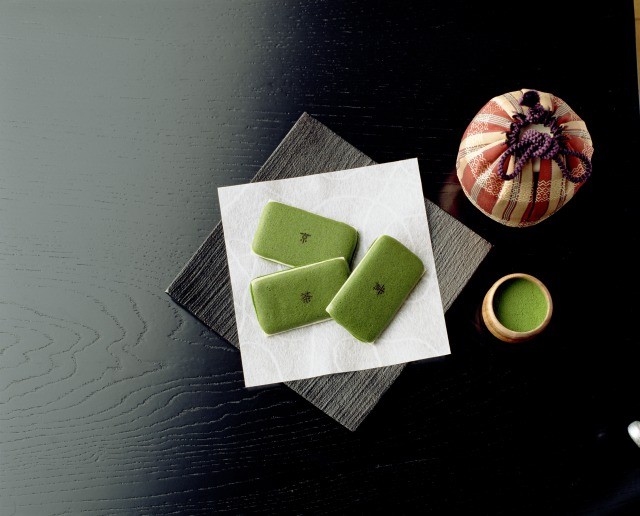Gift Giving
Modestly cloaking one’s sentiments
inside layers of wrapping,
conveying one’s thoughts quietly without words
is the graceful way
The tradition of wrapping or “tsutsumu” takes many forms in Kyoto. Kyotoites have for centuries refrained from directly conveying their true sentiments. Instead, they have refined the art of gift wrapping as a means of subtle communication. As senders honed their skills, recipients became deft at perceiving the thoughts and feelings enclosed. However, this custom was not just a show of gratitude. The packages embrace a sense of the seasons, sympathy, or delight as the recipient opens them.
Discover the hidden sentiments within the folds of wrapping culture.Whether you need to send gifts to Japan to thank a host or want to send a gift basket to a business partner, there are things you need to know.
The Custom of Wrapping
Numbers, colors and even printed animals can all accidentally offend someone if you don’t know what they mean. Below is a quick guide to help you find the perfect gift for every occasion.
- Gift-giving is an important part of Japanese business protocol. Moreover, gifts are exchanged among colleagues on July 15 and January 1 to commemorate midyear and the year’s end respectively.
- It is a good policy to bring an assortment of gifts for your trip. This way, if you are unexpectedly presented with a gift, you will be able to reciprocate.
- The emphasis in Japanese business culture is on the ritual of gift-giving, rather than the gift itself. For this reason, you may receive a gift that seems too modest, or conversely, extravagant. An expensive gift will not be perceived as a bribe.
- A wrapped gift is often carried inside a shopping bag to avoid ostentation and minimize any hint that a gift is about to be presented.
- The best time to present a gift is toward the end of your visit. You can discreetly approach the recipient, indicating that you have a small gift. Avoid giving a gift early in a relationship or at any conspicuous moment.
- A gift for an individual should be given in private. If you are presenting a gift to a group of people, have all of the intended recipients assembled.
- Present gifts with both hands.
- It is customary to comment that the gift you are presenting, even if it is extravagant, is ““tsumaranai mon” [“an uninteresting or dull thing”]. This statement is meant to convey, “Our relationship is more important than this trivial item.”
- It is a mistake to give the same gift to two or more Japanese of unequal rank. People will also take offense if you are in the presence of a group of people and give a gift to one person, but fail to give one to the others who are present.
- Gifts are opened in private, because if the gift turns out to be a poor choice, “loss of face” will result. Also, if several gifts are presented to people of different status, opening them privately prevents any possible comparisons.
- Before accepting a gift, it is polite to modestly refuse at least once or twice before finally accepting.
- Ensure that your gifts are wrapped. It’s safest to leave this task to a store or hotel gift-wrapping service.
- The safest gift-wrapping choices are pastel-colored papers, without bows. Avoid wrapping a gift with brightly covered papers or bows.
- If you are invited to a Japanese home, bring flowers [an uneven number], cakes or candy.
- If you receive a gift, be sure to reciprocate.
- Gifts in pairs are considered lucky.
Appreciated Gifts
- foreign, prestigious name-brand items
- imported scotch, cognac, bourbon, brandy or fine wines [top-quality brands only]
- frozen steaks
- gourmet foodstuffs, fresh fruit
- electronic toys [if children are on your gift-list]
- cuff links
- pen and pencil sets
- something that reflects the interests and tastes of the recipient
- a simple commemorative photograph [i.e.,taken from a gathering that the recipient attended]
Gifts to Avoid
- Lilies, lotus blossoms, and camellias are associated with funerals. White flowers of any kind should be avoided. There is also a superstition that potted plants encourage sickness.
- Giving four or nine of anything is considered unlucky.
- Red Christmas cards should be avoided, since funeral notices are customarily printed in this color.
Animals to Incorporate Into the GiftNow that you know what numbers to avoid, there are some things you can use to help add more meaning to your gift by using specific animals on the wrapping paper or on the actual gift itself.
- Butterflies can mean joy and longevity.
- Carp can mean good fortune and faithfulness.
- Cranes are perfect for weddings since they mean longevity and good fortune.
- Swallows or a swallow’s tail can represent good luck.
- Turtles can mean longevity making them ideal for baby showers.
Be Careful With Colors
Although you may write with black ink in your own country, when signing a gift card in Japan, you may want to change your pen. Colors have a lot of meaning and are something to be cautious of. Same goes for the color of the gift wrapping. Here is a quick guide on what you may or may not use color wise.
- Red is used on tombstones. Do not use it for signing cards. Also, don’t send red Christmas cards as funeral notices are red in Japan. Red and white gift wrapping is good for weddings, though.
- Black can mean death or bad luck. Black combined with red expresses sexuality, so try to avoid it.
- Green can mean eternity and good luck. It is perfect for almost any gift card.
- White can mean holiness. If the card is a solid color, white ink can be perfect for a baby shower.
- Purple can mean celebrations and decadence. It is a great color for a festive holiday.
When to Give a Gift?
There are many occasions when you’re expected to give a gift in Japan.
You’ve probably heard about the “giri choco” on Valentine’s Day. There’s the typical “omiyage” that you’re supposed to bring back from your trip. Gifts are also exchanged towards the end of the year (oseibo) to express indebtedness and midyear (ochugen) to show one’s gratitude. These kind of presents are exchanged among teachers, students, coworkers and business partners. You are expected to reciprocate if someone gives you one.
If you’re invited to somebody’s home, you always should bring a little present with you (e.g. cake, cookies or flowers).
And of course, there are the typical occasions we have in other countries as well such as Christmas, birthdays, weddings etc.
Giving and Receiving
Carry the gift in a normal shopping bag, so nobody will know immediately that you bring a present.When handing it over, do it with both hands (also when receiving it). If it is for an individual, you need to do it in private and you want to give it to the person towards the end of your visit, not in the beginning like in the USA.
It’s very common to present a gift with the words “Tsumaranai mono desu ga …”, lit.: It’s something boring, but please accept it …). It just shows that the relationship is more important that the present itself.
If you receive a present, don’t open it right away. Do it later when you’re alone, so you don’t have to worry about how to react if you don’t like it.
Also, it’s polite if you reject the present humbly once or twice. But don’t overdo it!
Always wrap a present beautifully. Let the shop do it where you purchased it.
The presentation and meaning of the gift are more important than the gift itself so make sure there is thought behind it.Most of these rules don’t apply when you give a present to a (close) friend or family member of yours. It’s a much more casual situation after all.
What Kind of Gifts are Best?
If you visit a Japanese company, your host family or meet with Japanese business partners, this question always pops up.
Food (especially sweets like cake, cookies etc.) from your region are very welcome. For women flowers can be nice, but avoid white flowers, lotus blossoms, lilies and camellias since they are associated with funerals. Also, potted plants are associated with sickness, so better look for something else.
High-quality alcohol or pens as well as business-card holders are also a nice idea. For business gifts it can be on the expensive side, but never have your own company’s logo on it!
If you’re visiting your host family, then anything that’s typical for your region / country(especially if it’s edible) is the best choice. Remember that much attention is given to the wrapping of presents. If not nicely packed, the present should at least be handed over in a bag, preferably a bag by the shop the present was purchased at. Gifts in sets of four are usually avoided because it is considered an unlucky number (the Japanese word for four is pronounced the same as the word for “death”). When handing over a present, both the gift giver and recipient use both hands.
Omiyage and Temiyage
Omiyage are souvenirs brought home from a trip while temiyage are thank-you gifts you bring when you visit someone. Japanese tourists tend to buy lots of souvenirs for their friends, relatives and co-workers. Consequently, tourist spots and airports feature many souvenir shops specializing in local foods and products.
When foreign visitors meet friends or a host family in Japan, it is not imperative for them to bring gifts, but it is a nice gesture that is appreciated. Recommended gifts items include food, drinks or other products from your home country. In general, they should be neither to cheap nor too expensive – typically between 1000 and 5000 yen. Note that there are restrictions on bringing certain types of food and plant products into Japan.
“But the classiest Kyoto omiage is Malebranche’s cha-no-ka,” a langues-de-chat sandwich cookie with a white chocolate center, flavored with regional Kyo Uji okoicha (strong tea).
Cha no Ka Confectionery (Malebranche)
This popular Western confectionery shop “Malebranche” set up their main branch in Kitayama, Kyoto, and they produce the matcha langue-de-chat confectionery “Okoicha Langue de Chat, Cha no Ka”. Using Uji matcha from Uji city in Kyoto, known for it’s matcha production, the flavor is a given but the color and aroma also make it a confectionary you can enjoy to the fullest. Apart from the company store, they can be purchased at the Isetan department store located directly from Kyoto station, Takashimaya in Shijo, Daimaru and other department stores. It’s only available in Kyoto so definitely buy it as a souvenir.

Ochugen and Oseibo
Twice a year, in June and December, it is common for co-workers, friends and relatives to exchange gifts. The gifts are called Ochugen and Oseibo respectively. On average, they are worth about 5000 yen and may be food, alcohol, household items or something similar. The gift giving seasons coincide with company employees receiving a special bonus in addition to their monthly salaries.
Birthday and Christmas
Gift giving on birthdays and Christmas is not originally a Japanese tradition. Due to the strong influence from the West, however, some families and friends exchange gifts also on these occasions.

